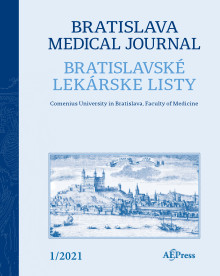Journal info
|
||||
Select Journal
Journals
Bratislava Medical Journal 2024 2023 2022 2021 2020 2019 2018 2017 2016 2015 2014 2013 2012 Ekologia - Ecology Endocrine Regulations General Physiology and Biophysics Neoplasma Acta Virologica Studia Psychologica Cardiology Letters Psychológia a patopsych. dieťaťa Kovove Materialy-Metallic Materials Slovenská hudba 2025Webshop Cart
Your Cart is currently empty.
Info: Your browser does not accept cookies. To put products into your cart and purchase them you need to enable cookies.
Bratislava Medical Journal Vol.120, No.7, p.527–531, 2019 |
||
| Title: Melatonin treatment prevents carbon tetrachloride-induced acute lung injury in rats by mitigating tissue antioxidant capacity and inflammatory response | ||
| Author: M. Radovic, L. Ristic, D. Krtinic, M. Rancic, V. Nickovic, ZN. Vujnovic Zivkovic, JB Zivkovic, MV Mirkovic, DR. Toskic, D. Sokolovic | ||
| Abstract: AIM: Carbon tetrachloride (CCl4) is an organic chemical that produces different tissue‑damaging effects when ingested or inhaled. Present study aims to determine whether the application of exogenous melatonin, a neurohormone with numerous biological properties, can prevent disturbances in lung tissue antioxidative capacities and arginine metabolism, tissue inflammation and oxidative damage induced by exposure to CCl4 in rats. METHODS: The effects of melatonin on the changes occurring in rat lung tissue after an acute exposure to CCl4 were studied by monitoring alterations in antioxidant capacities, inflammatory parameters, parameters of arginine metabolism, and lipid and protein oxidative damage. RESULTS: The results indicated that melatonin prevents CCl4-induced lung damage by mitigating tissue antioxidant capacity and preventing nitric oxide production through a shift from nitric oxide synthase to arginase. Also, melatonin partially prevented tissue inflammation and molecules’ oxidative modification seen after exposure to CCl4. CONCLUSIONS: The protective activity of melatonin can be attributed to its ability to scavenge both free radicals, as well as to its potential to increase tissue antioxidant capacity. The modulation of inflammatory response through both decrease in tissue inflammatory parameters and influence on arginine-nitric oxide metabolism might be an additional mechanism of action (Tab. 1, Fig. 2, Ref. 33). |
||
| Keywords: lung injury, carbon tetrachloride, melatonin, tissue antioxidant capacity, arginine metabolism | ||
| Published online: 12-Jul-2019 | ||
| Year: 2019, Volume: 120, Issue: 7 | Page From: 527, Page To: 531 | |
| doi:10.4149/BLL_2019_085 |
||
|
|
 download file download file |
|

